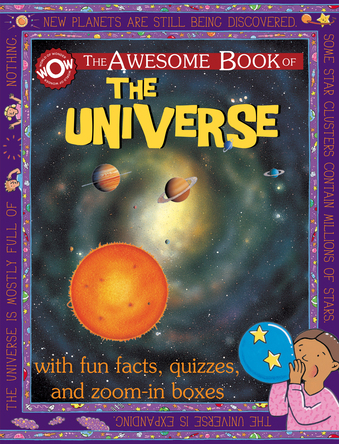Extrait du livre The Universe
Get ready to hear your kids say, “Wow! That’s awesome!” as they dive into this fun, informative, question-answering series of books! Students—and teachers and parents—will learn things about the world around them that they never knew before! This approach to education seeks to promote an interest in learning by answering questions kids have always wondered about. When books answer questions that kids already want to know the answers to, kids love to read those books, fostering a love for reading and learning, the true keys to lifelong education. Colorful graphics are labeled and explained to connect with visual learners, while in-depth explanations of each subject will connect with those who prefer reading or listening as their learning style. This educational series makes learning fun through many levels of interaction. The in-depth information combined with fantastic illustrations promote learning and retention, while question and answer boxes reinforce the subject matter to promote higher order thinking. Teachers and parents love this series because it engages young people, sparking an interest and desire in learning. It doesn’t feel like work to learn about a new subject with books this interactive and interesting. This set of books will be an addition to your home or classroom library that everyone will enjoy. And, before you know it, you, too, will be saying, “Wow! That’s awesome!” “People cannot learn by having information pressed into their brains. Knowledge has to be sucked into the brain, not pushed in. First, one must create a state of mind that craves knowledge, interest, and wonder. You can teach only by creating an urge to know.” - Victor Weisskopf
Introduction When you look up into the dark sky at night, have you ever wondered what is out there? You may know that the Earth is part of the solar system, but what is beyond that? This book will take you off into the far reaches of the universe. Find out how new planets are formed, discover how gravity works, and learn about the Big Bang that started it all, and the Big Crunch that may end it all. • In this book, a billion is one thousand million. On-the-spot quiz Q: Why watch out for these boxes? A: They give answers to the space questions you always wanted to ask. Space Bits Look out for these boxes to take a closer look at space features. Awesome Facts Watch out for these diamonds to learn more about the truly weird and wonderful facts about space and the universe in which we live.
The universe is mostly nothing just empty space. The universe The universe is very, very, very big— bigger than anything you can possibly imagine. It is not just all the stars, planets, and galaxies, but all the empty space in between. In fact, the universe is everything that exists, from the tiniest bit of an atom to entire galaxies. Which planet is named after the Roman goddess of love? Pluto Uranus Saturn Neptune Jupiter Mars Earth Venus Sun Mercury Q: How big is our solar system? A: Our solar system is so large, it would take you over 5,000 years driving in a fast car to get to Pluto, one of the five minor planets in our solar system. No one knows just how big the universe is, or even whether it has a definite edge. Some astronomers think it goes on forever. Others believe it is shaped like a doughnut. But with powerful telescopes scientists can see incredibly bright objects called “quasars,” which they believe may be on the edge of the universe. These could be as far as 7.45 billion trillion miles (12 billion trillion kilometers) away. Awesome Facts Our galaxy, the Milky Way, seems huge, but the universe contains at least 100 billion galaxies like ours.
The weird soup making up the early universe was five trillion times thicker than water! The Big Bang Scientists hypothesize that the universe began with an enormous explosion. One moment there was nothing, the next, there was a tiny, unbelievably hot, dense ball, containing all the matter in the universe today. Then a moment later, the universe existed, blasting itself into life with the biggest explosion of all time—the Big Bang. Q: How do we know about the Big Bang? A: Every galaxy in the universe is zooming away from ours. This shows the universe is expanding. By plotting back from the past how it has expanded, astronomers have worked out that the universe began about 13 billion years ago. 1. No one knows quite why it all started, but scientists think it all began with a small, incredibly hot ball. In the first split second, this grew to the size of a football, and then cooled down rapidly. 2. Gravity behaved very strangely. Instead of pulling things together, it blew them apart, and the universe expanded at terrific speed. In a split second, it grew bigger than a galaxy. 3. As the universe expanded, it cooled, and tiny particles of energy and matter began to appear. These particles formed a dense, immensely thick soup. 4. After about 3 minutes, gravity began to behave as it does now, drawing things together. Particles joined to make atoms, atoms joined to make gases, such as hydrogen and helium. 5. Gases clumped into clouds. After several hundred million years, these clouds began to form stars and galaxies. These galaxies merged into clusters and superclusters, and much later the Sun and solar system were formed. The universe is still expanding and new planets and stars are still being formed.
The Earth’s gravity keeps things like satellites in orbit around it. Gravity Every bit of matter in the universe is pulled towards every other bit by an invisible force called “gravity.” It is what keeps you on the ground and holds the solar system and the whole Exploring universe together. Jupiter is huge and is, in some ways, more like a star than a planet. Made mostly of hydrogen and helium, like the Sun, its strong gravity squeezes these gases until they are hot. Earth’s gravity pulls things to the ground— unless, like rockets, they use powerful engines to push in the opposite direction. Gravity also pulls the Moon into orbit around the Earth. The Sun’s gravity keeps Earth in orbit around it. Gravity is a mutual attraction between every bit of matter. A skydiver has a gravity that pulls, and he falls because his and the Earth pull each other together. But he falls to the Earth rather than Earth falling to him because the Earth is much heavier and pulls so strongly. Q: How is gravity used to guess the size of stars? A: The pull of gravity between two things like planets or stars depends on how massive they are, and how far apart they are. Astronomers can often tell how big a star is from how strongly its gravity appears to pull on nearby stars or planets.




























